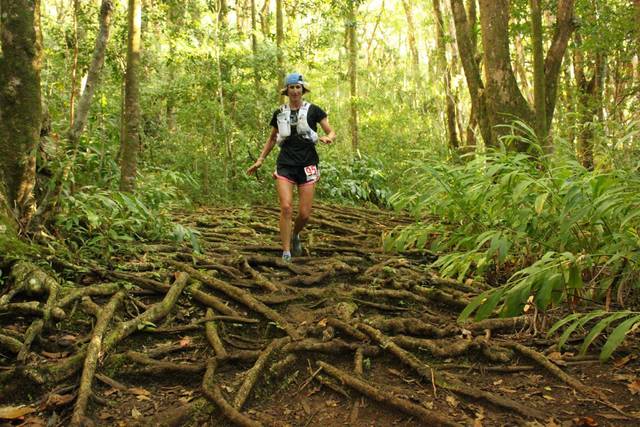Touted as one of the most remote self-supported stage footraces in the world, the inaugural Mauna To Mauna Ultra will showcase a course of unparalleled beauty and natural wonder. ADVERTISING Touted as one of the most remote self-supported stage footraces
Touted as one of the most remote self-supported stage footraces in the world, the inaugural Mauna To Mauna Ultra will showcase a course of unparalleled beauty and natural wonder.
On Sunday, 73 competitors from around the globe will find out what they are made of as they converge on Coconut Island to compete for bragging rights at the state’s first ultra multi-stage footrace.
The six-staged event will be held over seven days for a total of 155-miles with an accumulated elevation gain of 16,742 feet. Competitors will ascend and descend two massive volcanic mountains, endure extreme altitudes and weather conditions, and navigate various terrain: ancient rugged lava flows, expansive grasslands, river crossings, trails through lush rainforests and coastal beach pathways.
On the start list are two Big Islanders who are no strangers when it comes to competing in ultra-distance events.
Waimea’s Sylvia Ravaglia, 39, who has finished both the Hawaii HURT 100-mile trail race in Oahu and the Hawaii Ultraman World Championships in Kona, along with Laupahoehoe’s Alan Ryan, 46, a 2014 Hilo To Volcano 50K Ultra Champion and Lanai 50-miler finisher, will be competing in their first multi-stage Ultra race.
“It is something new. It’s an adventure that’s happening basically in our backyard,” Ryan said. “It’s a challenge to just finish while having to carry all of your equipment.”
Ryan said that he initially heard about the event last August when race organizers, Tess and Colin Geddes, were looking for people to help with the actual logistics of putting on an event that will traverse through some of the most awe-inspiring locations on the island.
The Big Island is home to the world’s most active volcano, Kilauea, the world’s tallest and longest mountains, Mauna Kea and Mauna Loa, and 11 of the world’s 13 climate zones that are responsible for the island’s unique ecological paradise.
The Geddes, founders and race organizers of the popular Grand To Grand Ultra — a 170-mile stage footrace held in September from Northern Arizona to Southern Utah — believed the Big Island would be the perfect venue to host their event and offer competitors a first-hand experience of Hawaii’s rich history and deep cultural roots.
The stages:
A stage footrace divides a route into specific distances, or stages, that need to be completed within a specified time frame, and each stage ends with participants camping together overnight before beginning another stage the following day.
The Mauna To Mauna Ultra are divided into six stages that spans over seven days for a total of 155 miles and an elevation gain of 16, 742 feet. The stages have been designated as follows: Stage 1 (20.5-miles), Stage 2 (21.1-miles), Stage 3 (30.4-miles), Stage 4 (49.1-miles), Stage 5 (26.1-miles), and Stage 6 (6.2-miles).
Self-Supported
Despite the physical challenges competitors will endure just to get to the finish line on Day 7, another daunting task requires participants to carry everything they need for all seven days, on their back.
“I’m bringing a sleeping bag, a down jacket, sunscreen, sunglasses, dehydrated food which is about 14,000 calories or basically 2,000 calories per day, a blister kit — basically everything I’ll need to get through this race for a week. Water and a tent for camping are the only things race organizers will provide,” Ryan said.
Type of competitors
With the field limited to just 100 competitors, many have commented that this event has kept a low profile, as most of the local running community had no idea it was happening.
Mauna To Mauna Ultra attracts a very specific clientele, like those who have done previous Ultra running events or IRONMAN distance races, but are looking for a new challenge. Other reasons include the race organizers setting a specific quota of entrants from each country, just 30 spots reserved for USA and Canada combined, and the fact that the entry fee for the week-long race is $3500. It’s certainly not a race for the “Average Joe.”
The event will conclude May 20, with overall winners based upon their cumulative time for the stages.
Registration for the Mauna To Mauna is closed but for more information visit their website at m2multra.com.



